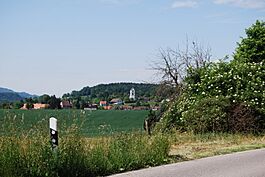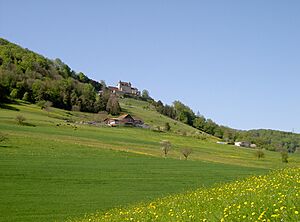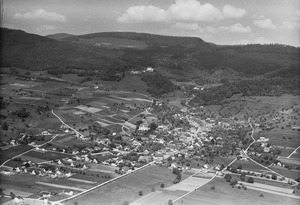Lostorf facts for kids
Quick facts for kids
Lostorf
|
||
|---|---|---|

Lostorf village
|
||
|
||
| Country | Switzerland | |
| Canton | Solothurn | |
| District | Gösgen | |
| Area | ||
| • Total | 13.25 km2 (5.12 sq mi) | |
| Elevation | 451 m (1,480 ft) | |
| Population
(Dec 2020 )
|
||
| • Total | 3,963 | |
| • Density | 299.09/km2 (774.7/sq mi) | |
| Postal code |
4654
|
|
| Surrounded by | Niedergösgen, Obergösgen, Rohr, Stüsslingen, Trimbach, Winznau, Wisen, Zeglingen (BL) | |
| Twin towns | Rielasingen (Germany) | |
Lostorf is a small town, also called a municipality, located in Switzerland. It's found in the Gösgen district, which is part of the Solothurn canton.
Contents
A Look Back in Time: Lostorf's History
Lostorf was first written about a very long time ago, between the years 1145 and 1153. Back then, it was called de Loztorf.
Exploring Lostorf's Geography
Lostorf covers an area of about 13.26 square kilometers (5.12 square miles). A big part of this land, about 37.7%, is used for farming. Nearly half of the area, 48.8%, is covered by forests.
The town itself, with its buildings and roads, takes up about 13.8% of the land. A tiny part, 0.1%, is land that can't be used for anything. Most of the built-up area is made of houses and other buildings.
The forests are very dense, covering 47.2% of the total land. Some smaller areas have orchards or groups of trees. For farming, 15.2% of the land grows crops. Another 17.7% is used for pastures where animals graze.
Lostorf is located in the Gösgen district. It sits near the bottom of the Dottenberg and Reitifluh Mountains. The municipality includes the main village of Lostorf and two smaller areas called hamlets: Mahren and Bad Lostorf.
Lostorf's Coat of Arms
The official design of Lostorf's coat of arms is quite special. It shows three red roses with green leaves and stems. These roses appear to be growing out of a green hill with three small bumps. The background color of the shield is gold.
Lostorf's Population and People
Lostorf has a population of about 4,000 people. In 2008, about 8.5% of the people living here were from other countries. Over ten years, from 1999 to 2009, the number of people living in Lostorf grew by 10.2%.
Most people in Lostorf speak German. In 2000, about 94.6% of the population spoke German. Italian was the second most common language, spoken by 1.2% of the people. Serbo-Croatian was third, spoken by 0.6%. A small number of people also spoke French or Romansh.
In 2008, the population was almost evenly split between males (49.8%) and females (50.2%). Most residents were Swiss citizens. About 28.5% of the people in Lostorf in 2000 were born there. Another 28% were born in the same canton (Solothurn). About 31.3% were born elsewhere in Switzerland, and 10% were born outside of Switzerland.
Age Groups in Lostorf
Looking at the age of people in Lostorf in 2000:
- About 8.6% were children aged 0 to 6 years old.
- About 17.1% were teenagers aged 7 to 19.
- Adults aged 25 to 44 made up the largest group, at 29.9%.
- People aged 45 to 64 made up 26.9%.
- Seniors aged 65 to 79 made up 10.2%.
- About 2.7% of the population was over 80 years old.
Households in Lostorf
In 2000, there were 1,339 private households in Lostorf. On average, there were 2.6 people living in each household.
- About 21.1% of households had only one person.
- 102 households had five or more people.
- Many households were married couples, some with children and some without.
- There were also 53 single parents living with their children.
The historical population of Lostorf is shown in the chart below:

Lostorf's Economy and Jobs
In 2010, Lostorf had a low unemployment rate of 1.8%. This means most people who wanted to work had a job.
Types of Jobs
In 2008, there were 603 full-time jobs in Lostorf. These jobs were in different areas:
- Primary Sector: 48 jobs were in farming. This sector deals with getting raw materials from nature.
- Secondary Sector: 163 jobs were in this sector. Most of these were in manufacturing (making things) and construction (building things).
- Tertiary Sector: 392 jobs were in this sector, which provides services. These jobs included sales, transportation, hotels, restaurants, and healthcare. Many people also worked as technical experts or scientists.
Many people who live in Lostorf travel to other towns for work. In 2000, 1,378 residents worked outside the municipality. About 14.2% of workers used public transportation, while 64.7% drove their own cars to work.
Religion in Lostorf
Based on information from 2000, people in Lostorf follow different religions:
- About 45.4% were Roman Catholic.
- About 31.1% belonged to the Swiss Reformed Church.
- Smaller groups included members of Orthodox churches, the Christian Catholic Church, and other Christian churches.
- There were also people who followed Islam or Buddhism.
- About 14.9% of the population did not belong to any church or considered themselves agnostic or atheist.
Education in Lostorf
Education is very important in Lostorf. In 2000, about 42.6% of the population had finished upper secondary education. This is like high school. Another 14.5% had gone on to higher education, such as university.
School System
During the 2010-2011 school year, Lostorf had 348 students in its school system.
- Kindergarten: In the Canton of Solothurn, children can attend two years of kindergarten, which is not mandatory. Lostorf had 79 children in kindergarten that year.
- Primary School: Students must attend six years of primary school. Lostorf had 262 students in primary school. Some students were in smaller, special classes.
- Secondary School: After primary school, students go to lower secondary school for three years. All students from Lostorf attend their secondary school in a nearby town. After this, they can choose to go to advanced schools for three to five more years.
In 2000, 57 students came to Lostorf from other towns for school. However, 254 residents of Lostorf went to schools outside the municipality.
- Paul Sahli, juggler
See also
 In Spanish: Lostorf para niños
In Spanish: Lostorf para niños






